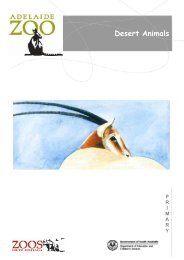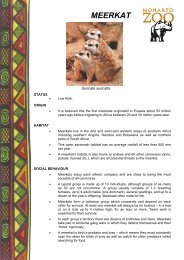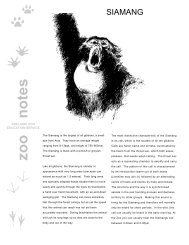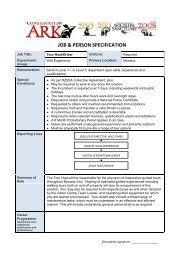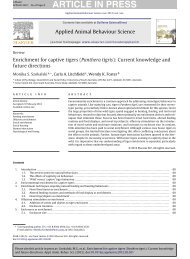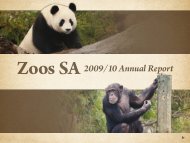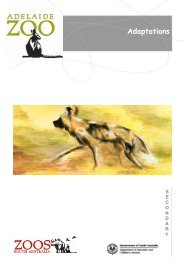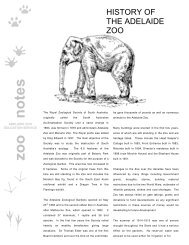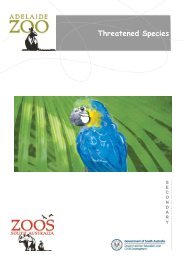2008 - 2009 Annual Report - Zoos South Australia
2008 - 2009 Annual Report - Zoos South Australia
2008 - 2009 Annual Report - Zoos South Australia
- No tags were found...
Create successful ePaper yourself
Turn your PDF publications into a flip-book with our unique Google optimized e-Paper software.
CONTENTSYear In ReviewPresident and CEO’s <strong>Report</strong>Conservation ProgramsAssets and InfrastructureConservation EducationThe AnimalsLiving collectionsStatus of Animal CollectionsAnimal InventoryThreatened SpeciesOperationsCommunications and PartnershipsVisitor ExperiencesHuman ResourcesFinancial <strong>Report</strong>FinalsStatus of Animal CollectionsThis document was initially prepared as a monthly reportingdocument in 2007 from the Collection Development Teamto the Board of the Society. However, as the documentevolved, it became apparent that changes to the Adelaide andMonarto Zoo collections would not be apparent over sucha short period of time, and that it may be more valuable forsite and master planning purposes. Displaying the collectionunder a number of different categories, this report highlightshow the collection is progressing towards desired aspects ofcollection management. This report is provided annually totrack the progress of the animal collection.As the human population grows and impacts at an increasingrate on plant and animal species across the globe, zoosand aquaria are becoming critical for the survival of manyspecies, and an integral part of in situ conservation programsfor many others. While individual animal collections areoften too small to be of much value to long-termconservation, co-operative international and/or regionalex situ breeding programs form large, viable populationsthat can make a difference.Furthermore, if managed correctly, there is the potential toprovide demographic and genetic insurance populations.Adelaide Zoo and Monarto Zoo, as members of theAustralasian Regional Association of Zoological Parks andAquaria (ARAZPA), are committed to co-operatively managingtheir animal collections in order to promote sustainability andto contribute towards species conservation.Following The World Zoo Conservation Strategy, there are twoconsiderations that are important in the process of choosingspecies for ex situ management within Australasian zoos:1. What species will best serve the broad-based conservationgoals of ARAZPA zoos?2. What are the capabilities and strength of ARAZPA zoos inregard to their knowledge, experience and resources?Aside from contributing to the conservation of a species,these ex situ programs also provide animals for publiceducational and/or exhibit opportunities; provide researchcollections from which to gain basic knowledge of animalbiology and husbandry; and provide fundraising material.Botanic Estate - 1 of 2



